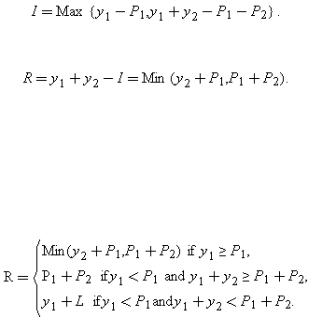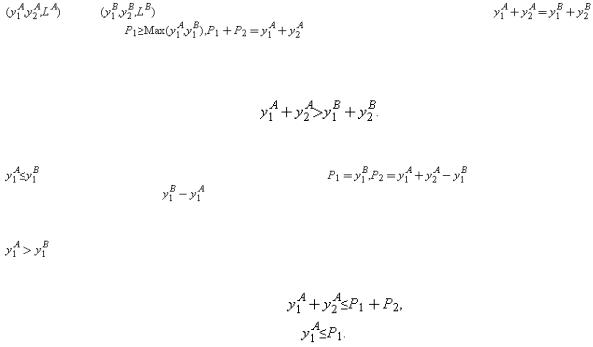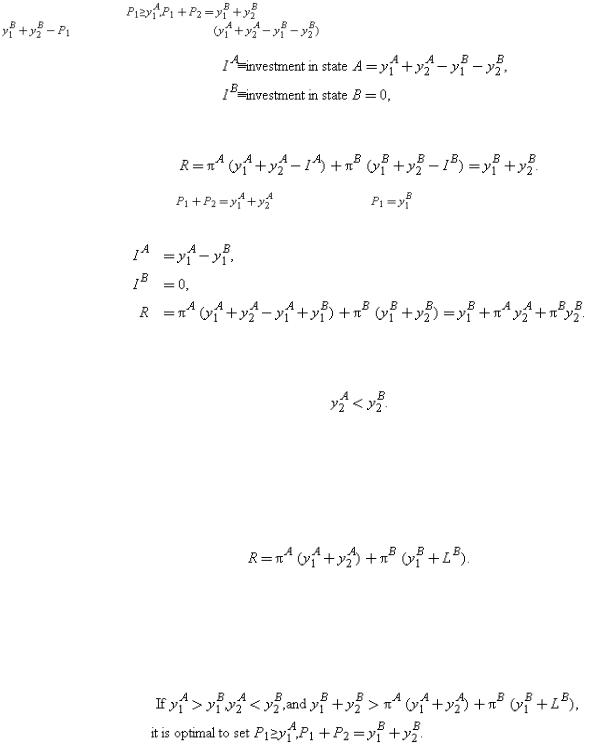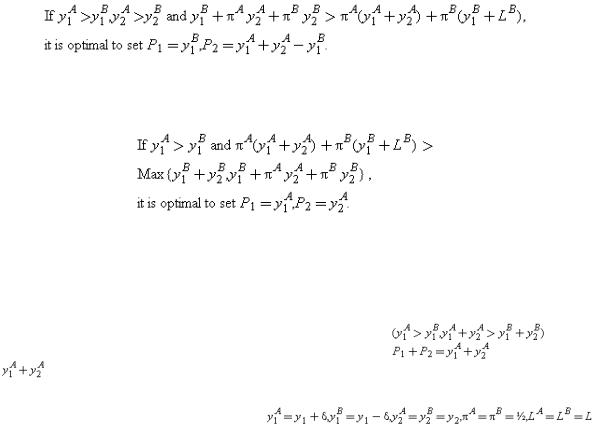
Учебный год 22-23 / Firms, Contracts, and Financial Structure
.pdf150 |
II. UNDERSTANDING FINANCIAL STRUCTURE |
Note, however, that this effect disappears if the manager is on an incentive scheme such as (6.7) (and he is forbidden from holding additional shares). Under these conditions his total reward depends only on the firm's ex post total value—y1+y2 or y1+L—and not on the split between shareholders and creditors. Thus, the manager no longer has any incentive to issue debt rather than equity.167
Finally, consider the view that firms issue debt in order to ‘complete’ the market (see e.g. Stiglitz 1974, and Allen and Gale 1994). The idea behind this is that risk-averse investors may be interested in holding claims conditional on a firm's profit, other than just shares, in the absence of a full set of Arrow–Debreu securities. The firm can cater to such investors by issuing risky debt as well as equity and can thereby raise its market value.
There are two difficulties with this as a theory of capital structure, however. First, it is not clear why the firm has to issue these more complicated claims itself; other traders in the market can and do issue such ‘derivative’ claims. Second, if the purpose of these claims is solely to enrich the available investment opportunities, why does a failure to make a payment to creditors trigger the firm's default and bankruptcy; i.e., why doesn't the firm issue preferred shares that specify that claim-holders are owed a fixed amount, but that the firm can pay out less in the absence of a dividend to shareholders? Preferred shares offer the same return stream as risky debt if the manager is selfless; however, they have the great advantage that they avoid the inefficiency costs of bankruptcy.
>This section—and the chapter as a whole—can be summed up as follows. Taxes, asymmetric information, and incomplete markets are all undoubtedly important influences on the choice of a firm's capital structure. However, these factors alone cannot explain why debt has the feature that it is senior and that a failure to pay leads to a penalty in the form of bankruptcy, i.e. why debt is associated with a ‘hard’ budget constraint.168 At the risk of belabouring
167This observation has also been made by Dybvig and Zender (1991). The above discussion does not do full justice to the Myers–Majluf model (or to other asymmetric information theories of debt). For a fuller account, see Hart (1993).
168A qualification should be made. Some writers have argued that, even if the management is selfless, senior debt may be useful as a way of bonding the firm if it engages in
strategic behaviour in product markets or in bargaining with unions; see Baldwin (1983), Brander and Lewis (1986), and Perotti and Spier (1993). Although strategic effects may well be important, however, it would be surprising if they alone could explain the widespread use of (senior) debt or the variations in debt across industries, countries, or over time. On the latter, see Rajan and Zingales (1994).
6. CAPITAL STRUCTURE OF A PUBLIC COMPANY |
151 |
the obvious, note that the theory developed in this chapter does explain these facts. If debt were postponable, the manager would never be forced to liquidate in model 1 or to pay out free cash flow in model 3. If debt were junior, the manager could finance an unprofitable investment in models 2 and 3 by issuing debt at date 1 that was senior to existing debt.
The conclusion is that, although the agency approach may not be the whole story, it would seem to be an essential part of any fully developed theory of capital structure.169
169One weakness of the models I have presented in this chapter is that they do not explain why firms issue dividends. In these models, the managers always (weakly) prefer to retain profits and use them to build a bigger empire. (Shareholders receive a ‘liquidating’ dividend at date 2, but only because by assumption the firm is wound up.) One way to explain dividends is to drop the assumption that shareholders are completely passive. The manager may then pay a dividend in order to deter a large shareholder or a take-over bidder from intervening in the company's affairs. In fact, the debt-equity swaps considered in §5 had this character. Developing a convincing model of dividend behaviour is a very important topic for future research.

152 |
II. UNDERSTANDING FINANCIAL STRUCTURE |
Appendix
Another Role of Short-Term Debt: Model 3
Model 3 combines models 1 and 2; i.e. investment and liquidation are both allowed. The following assumption is made.
ASSUMPTION A1. y2>L with probability 1. Also, given any number i, the manager has a new investment project costing i and this project yields r=0.
Given this assumption, the role of short-term debt is to force the manager to pay out free cash flow without triggering liquidation.
Consider the manager's situation once the uncertainty has been resolved at date 1. If y1≥P1, the manager can invest y1−P1 out of current earnings. However, he may be able to invest more by borrowing. The most he can borrow is y1+y2−P1−P2. It follows that his maximum investment is
Since investment is totally unproductive, it follows that the return to initial security-holders is:
Suppose next that y1<P1. Then the manager can avoid default at date 1 if y1+y2≥P1+P2. In this case he will invest y1+y2−P1−P2 and the return to investors will be P1+P2. On the other hand, if y1+y2<P1+P2, default will occur and the firm will be liquidated.
Putting all the cases together, one finds that the return to investing is(6A.1)
The next step is to analyse optimal capital structure in this third model. It is easy to achieve the first-best outcome if there is no ex ante uncertainty about y1, y2, and L. Simply set P1≥y1, P1+P2=y1+y2. Then the manager can't invest since there is no free cash flow; but also he can avoid liquidation (possibly by borrowing).

6. CAPITAL STRUCTURE OF A PUBLIC COMPANY |
153 |
When there is uncertainty, matters are more complicated. Again simplify by supposing that (y1, y2, L) takes on just two |
|||
values |
and |
, with probabilities πA and πB = 1−πA, respectively. If |
, the first-best |
can be achieved by setting |
. The reason is that, as in the case of certainty, there is no free |
||
cash flow, but the manager can avoid liquidation in the lower y1 state by borrowing. So suppose without loss of generality that(6A.2)
Consider two subcases. |
|
|
|
1. |
Here the first-best can be achieved by setting |
. In state A, the manager pays the |
|
|
date 1 debt by borrowing |
. In state B the manager can repay P1 |
out of current earnings. The manager is |
|
able to avoid default in both states but has neither the free cash nor the borrowing capacity to make new |
||
2. |
investments. |
|
|
Now the first-best cannot be achieved. The reason is that for there to be no slack in state A it must be |
|||
|
the case that |
|
|
But then the firm will go bankrupt in state B. There are two basic choices. First, P1 and P2 can be set so that bankruptcy is avoided in both states but some investment occurs in state A. Second, P1 and P2 can be set so that no investment occurs in state A, but the firm goes bankrupt in state B.
Avoiding Bankruptcy.
Consider the first choice, where bankruptcy is avoided in both states. Obviously there is no reason to have slack in state B as well as in state A. There are two ways to achieve

154 |
II. UNDERSTANDING FINANCIAL STRUCTURE |
this. One is to set |
, in which case the manager avoids liquidation in state B by borrowing |
, but is able to invest |
in state A. That is, |
and the expected return to initial security holders is
The second option is to set |
but to choose |
, so that the manager can repay his debts without |
borrowing in state B. In this case, |
|
|
Option 1 is preferred to option 2 if and only if it generates a lower value of (totally unprofitable) investment, i.e. if and only if
Triggering bankruptcy.
Consider next the second choice, which is to trigger bankruptcy in state B. Under these conditions, it is optimal to set  to avoid slack in state A. The return to initial security holders is then
to avoid slack in state A. The return to initial security holders is then
The final step of subcase 2 is to compare the values of R from avoiding bankruptcy and triggering bankruptcy. The results for subcase 2 overall are summarized in (6A.3)–(6A.5). (To obtain the results for model 3 overall, one must combine (6A.3)–(6A.5) with subcase 1, which is concerned with the situation  .)(6A.3)
.)(6A.3)
That is, total debt is set such that the firm just avoids bankruptcy in state B by borrowing, but the firm has enough debt capacity in state A to make an unprofitable investment.

6. CAPITAL STRUCTURE OF A PUBLIC COMPANY |
155 |
(6A.4)
That is, debt levels are set such that the firm can avoid bankruptcy in state B by paying its short-term debt out of current earnings, but the firm has free cash flow in state A which it can use to make unprofitable investments.(6A.5)
That is, debt levels are set such that the firm just avoids bankruptcy in state A by paying its debts out of current earnings, but goes bankrupt in state B.
This concludes our analysis of model 3.
It remains to establish two results from Section 5. To see that model 3 supports the existence of a positive relationship
between debt and asset tangibility, consider subcase 2 of the two-state case |
. As LB rises, it |
|
becomes more likely that (6A.5) applies rather than (6A.3) or (6A.4). Since |
in (6A.5), while it is no |
|
greater than |
in (6A.3) and (6A.4), the conclusion is that P1+P2 rises (weakly) as LB rises. |
|
Consider next the relationship between debt and the stability of cash flows. Start off with the case where y1 and y2 are certain. Then it is optimal to set P1=y1, P2=y2. Now set , where δ>0. Then, according to (6A.3)–(6A.5), if 1/2y2−δ>1/2L, it is optimal to avoid bankruptcy in both states. One way to do this is to set P1=y1+δ, P2=y2−2δ. In this case it can be said that an increase in uncertainty reduces (total) debt. On the other hand, if 1/2y2−δ<1/2L, it is optimal to trigger bankruptcy in state B by setting P1=y1+δ, P2=y2 (see (6A.5)). In this case, an increase in uncertainty increases total debt.
7 Bankruptcy Procedure
THE last two chapters have analysed the financial structure of a closely held company (Chapter 5) and a public company (Chapter 6). It was argued that debt can play an important role in constraining managers or owners of both kinds of company. In the Hart–Moore model of Chapter 5, debt forced an entrepreneur to pay out funds to investors rather than to himself. In the various models of Chapter 6, debt forced the sale of assets and limited a manager's ability to make unprofitable, but power-enhancing, investments.
Of course, given that a company takes on debt, there will be circumstances, arising perhaps from an unexpected shock, in which the company will default on this debt. In such a situation, the company is (in effect) bankrupt. The question is: what should happen in a bankruptcy state? (To put it another way, what lies behind the ‘liquidation’ value L in Chapters 5 and 6?) This is the topic of the present chapter.
The chapter begins with a discussion of the need for, and goals of, a formal bankruptcy procedure (Sections 1 and 2). Section 3 describes existing procedures in the West, with a particular emphasis on US and (to a lesser extent) UK procedures. The two main US procedures are ‘Chapter 7’ and ‘Chapter 11’. Chapter 7 calls for a bankrupt company to be sold off for cash. In contrast, Chapter 11 is an attempt to allow companies to reorganize. Unfortunately, there is widespread dissatisfaction with both procedures. Chapter 7 is thought to lead to the liquidation of healthy companies. Chapter 11 has been criticized for being cumbersome and biased in favour of reorganization under incumbent management. Chapter 11 is also flawed because it mixes the decision of what should happen to the company with the decision of who gets what. This leads to a great deal of haggling.
Section 4 turns to a procedure—proposed elsewhere by Philippe Aghion, John Moore, and myself—that tries to combine
7. BANKRUPTCY PROCEDURE |
157 |
the best features of Chapters 7 and 11.170 (The procedure uses in a significant way an idea of Lucian Bebchuk; see Bebchuk (1988).) In the Aghion–Hart–Moore (AHM) procedure, debt claims are converted into equity, and the decision about whether to liquidate or reorganize is then put to a vote by the new shareholders. Sections 5–7 discuss some practical difficulties concerning the AHM procedure and how they might be resolved, and provide some concluding remarks.
As mentioned earlier, the style of this chapter is very different from that of the others in the book. There is no model, and the argument is conducted at a fairly informal level. The chapter attempts to apply theoretical ideas to throw light on an important practical issue. It should be judged by whether it is successful in this regard.
1.The Need for a Formal Bankruptcy Procedure
It is helpful to begin the discussion with the case studied in Chapter 5 of a single debtor and a single creditor. It was observed there that default is an event where control of the assets shifts from the debtor to the creditor; that is, the creditor becomes the new owner of the assets. In this simple case there is little if any need for a formal bankruptcy procedure. Bankruptcy procedure should do no more than ensure that a transfer of ownership and control does take place in the default state, i.e. that the terms of the debt contract are upheld. After this, the creditor should have the right to decide whether to sell off the assets, or renegotiate her debt contract with the entrepreneur, so as to keep the assets in place.171
Matters become more complicated when there are many creditors (the situation studied in Chapter 6). The problem is that in this case it is not really clear what a ‘transfer of ownership and
170 See Aghion et al. (1992, 1994a, 1995). This procedure also appears as Appendix E in ‘The Insolvency Service, the Insolvency Act 1986: Company Voluntary Arrangements and Administration Orders, A Consultative Document’ (1993), London.
171However, Harris and Raviv (1995) argue that there is a role for a state-provided bankruptcy procedure even in the single debtor–single creditor case, whose purpose would be to reallocate bargaining power between the debtor and the creditor.
158 |
II. UNDERSTANDING FINANCIAL STRUCTURE |
control to (all the) creditors’ means. In the absence of a formal bankruptcy procedure, the law provides a creditor with two main remedies in the event of a default. First, with regard to a secured loan, the creditor can seize the assets that serve as collateral for the loan. Second, with regard to an unsecured loan, the creditor can sue the debtor and call on a sheriff to enforce the court's judgment, possibly by selling the debtor's assets (see Baird and Jackson 1985).
Difficulties arise when the debtor has insufficient assets to cover his liabilities (which is very likely to be the case—otherwise why would the debtor have gone bankrupt?). Creditors may then engage in a socially wasteful race to be first to seize their collateral or to obtain a judgment against the debtor.172 Also—and perhaps more important—this race may lead to the dismantlement of the debtor's assets and to a loss of value for all creditors if these assets are worth more as a whole than as a collection of pieces.
Given this, it is in the collective interest of creditors that the disposition of the debtor's assets be carried out in an orderly manner. This is the rationale for a formal bankruptcy procedure.
Nothing so far implies that the formal bankruptcy procedure needs to be provided by the state rather than by the parties themselves. In a world of costless contracting, debtors and creditors would anticipate the possibility of default and the consequent collective action problems and specify as part of their initial contract what should happen in a default state—in particular, whether the company should be reorganized or liquidated and how its value should be divided up among various claimants.
In practice, transaction costs may be too large for debtors and creditors to design their own bankruptcy procedure contractually, particularly in situations where debtors acquire new assets and new creditors as time passes. Instead, parties may prefer to rely on a ‘standard form’ state-provided bankruptcy procedure. It is a long way from this observation, however, to any conclusions about the nature of an optimal standard-form procedure. The problem is that a satisfactory analysis of an optimal procedure requires a theory both of why contracts are incomplete, and of how the state can overcome this incompleteness. Chapters 2–4 shed some light on the first of these questions, but not on the second.
172 See Jackson (1986). The race to be first is a negative-sum game since wins and losses cancel out and everybody spends resources to play the game.
7. BANKRUPTCY PROCEDURE |
159 |
In particular, in Chapters 2–4 contractual incompleteness was the result of the courts' inability to observe variables that the parties could observe. Thus, the courts were the source of contractual incompleteness rather than the solution.173
In what follows, therefore, optimal bankruptcy procedure is not derived from first principles. Instead, some goals that an efficient bankruptcy procedure should satisfy are suggested, and a procedure is described that does a reasonable job of meeting these goals. It will be argued that the procedure presented is practical and avoids some of the pitfalls of existing procedures. Also, the procedure is sufficiently simple and natural that future work may show it to be optimal within a reasonable class of procedures.174
2.Goals of a Bankruptcy Procedure
As mentioned above, the analysis does not proceed from first principles. However, economic theory suggests that the following are desirable goals for a bankruptcy procedure.
1.A good bankruptcy procedure should achieve an ex post efficient outcome (that is, an outcome that maximizes the total value of the proceeds—measured in money terms—received by the existing claimants).175
2.A good bankruptcy procedure should preserve the (ex ante) bonding role of debt by penalizing managers adequately in bankruptcy states. However, bankruptcy should not be so
173For a further discussion of this, see Hart (1990). Also, for an analysis of the courts' role in filling in the gaps in incomplete contracts, see Ayres and Gertner (1989).
174It is not suggested that the procedure, if adopted, should be mandatory. Anybody who wishes to deviate from it and design their own procedure should be allowed to do so.
175Note that ‘external’ considerations are excluded from the definition of efficiency; that is, it is assumed that the important benefits and costs have been incorporated into the valuation of the firm. For example, such items as the external benefit from maintaining employment in the local area are not included. If there are external considerations, government action may indeed be warranted, but bankruptcy law is the wrong instrument for dealing with such considerations. It would be better to have a general employment subsidy to save jobs rather than distort bankruptcy procedure in order to save bad firms.
